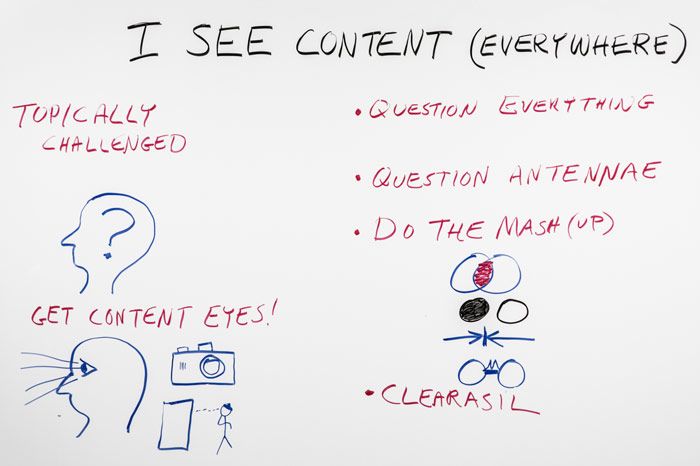Most of us who work in content marketing have felt the strain that scaling puts on our efforts. How on Earth are we supposed to keep coming up with great ideas for new pieces of content? The answer is, in some sense, all around us. In today’s Whiteboard Friday, MozCon community speaker Mark Traphagen shows us how to see the world in a different way—a way that’s chock full of content ideas.
Heads-up! We’re publishing a one-two punch of Whiteboard Fridays from our friends at Stone Temple Consulting today. Stay tuned later in the day for one from Eric Enge!
Hey, hello. I’m Mark Traphagen from Stone Temple Consulting, and welcome to this week’s Whiteboard Friday. I want to talk to you today, starting out, about a movie that I hope you’ve all seen by now, because this should not be a spoiler alert. I’m not even going to spoil the movie, but it’s “The Sixth Sense.”
Most of you know that movie. You’ve seen it and remember it. The little kid who says that creepy thing: “I see dead people.”
What I want to give to you today, what I want to try to teach you to do and bring to you is that you see, not dead people, but content and see it everywhere. Most of us realize that these days we’ve got to be producing content to be effective on the Web, not only for SEO, but to be effective in our marketing, in our branding and building the reputation and trust authority that we need around our brand. That’s going to be happening by content.
We’re all topically challenged
But if you’re the one tasked with coming up with that content and you’ve got to create it, it’s a tough job. Why? Most of us are topically challenged. We come to that moment, “What do I write about? What do I do that video about? What do I make that podcast about? What’s the next thing I’m going to write about?” That’s going to be the hardest thing.
When I talk to people about this, people who do this, like I do every day for a living, producing, inventing content, they’re almost invariably going to put that in the top three and usually number one. What do I do? Where do I get this from?
It’s more important now than ever before. It used to be just most companies that did content at all, websites, would hire an SEO copywriter. They’d actually use that term. We need an SEO copywriter. That usually meant that we’re looking for somebody who’s going to know where to put the keywords in enough times, and we don’t really care what else goes on with the content, what they write or how they say it or how good a writer they are as long as they can know the ways to manipulate the search engines.
Well, I think most of us now, if you watch these Whiteboard Friday videos, you know it, that that just doesn’t work anymore. That’s not going to cut it. Not only does that not really work with the search engines so well anymore, but it’s not really using your content effectively. It’s not using it to build, again, that reputation, that trust, that authority that you need around your brand and that content can be so powerful to do.
Get yourself some cyborg content eyes
So what I’m going to challenge you to do today is to get content eyes. You’ve got to get content eyes. You’ve got to get eyes that see content everywhere. This is what I train myself to do. It’s why I’m never out of ideas for that next blog post or that next video. You start to see it everywhere. You’ve got to get those eyes for it.
You’ve got to be like that professional photographer. Professional photographers are like this. This is what they have. Some of them, maybe they are born with it, but I think a lot of them have just developed it. They train themselves that everywhere they walk, when they’re going down the city street, when they’re out in the country, or wherever they are, they see photographs. The rest of us will walk right by it and say, “That’s just stuff happening.” But they see that old man on the street that has a face that tells a story of long ages. They see the way that shadow falls across the street at that moment, that right time of day. They see that’s a photograph. That’s a photograph. That’s a photograph.
You’ve got to start looking for that with content. You’ve got to be like Michelangelo. According to legend anyway, he said that he could look at a block of granite and see the sculpture that was inside it, waiting for him to chisel it out. That’s what you’ve got to train yourself to do.
So what I want to do today with the rest of this time is to give you some ways of doing that, some ways that you can look at the other content that you’re reading online, or videos you’re watching, conversations that you get into, listening to a conference speaker, wherever you are to start to look for that and get those content eyes. So let’s break into what those are.
Like the bumper sticker says, question everything
By questioning everything here, I mean develop a questioning mind. This is a good thing to do anyway when you’re reading, especially when you’re reading non-fiction content or you’re looking at and evaluating things. But for the content producer, this is a great tool.
When I’m looking at a piece of content, when I’m watching one of Rand’s Whiteboard Friday videos, I don’t just say, “Oh, it’s Rand Fishkin. I’ve got to take everything that he says.” I formulate questions in my mind. Why is that true? He just went past that fact there, but how does he know that?
Wait, I’d like to know this, but I’m looking at a Whiteboard video. I could yell at it all day, and Rand’s not going to answer me. But maybe instead of just putting that question in the comments, maybe that becomes my next piece of content.
Install a question antenna
So question everything. Get those questions. Related to that — get a question antenna up. Now what I mean by that is look for questions that are already there, but aren’t getting answered. You see a great blog post on something, and then you look in the comments and see somebody has asked this great question, and neither the author of the blog post nor anybody else is really answering it adequately. Chances are, if that’s a really great question, that person doesn’t have it alone. There are a lot of other people out there with that same question.
So that’s an opportunity for you to take that and make a piece of content out of it. We’re talking here about something that’s relevant to the audience that you’re after, obviously. So that’s another thing is looking for those questions, and not just on other pieces of content, but obviously you should be listening to your customers. What are the questions they’re asking? If you don’t have direct access to that, talk to your sales staff. Talk to your customer service people. Whoever interfaces with the customers, collect their questions. Those are great sources of content.
Finally, here, not finally. Second to finally, penultimate, do the mash-up. I love mash-ups. I’m totally obsessed with them. It’s where somebody, an artist goes and takes two or three or sometimes more pieces of pop music –
they could be from different eras — and puts them together in a very creative way. It’s not just playing one after the other, but finds ways that they sonically match up and they can blend over each other. It might be a Beatles song over Gangster’s Paradise. A whole new thing happens when they do that.
Juxtapose this! By which I mean do a mash-up.
Well, you can do mash-ups. When you’re reading content or watching videos or wherever you’re getting your stimulation, look for things that juxtapose in some way, that you could bring that in, in some way that nobody’s done before.
Quickly, there are four kinds of things you should be looking for to do your mash-up. Sometimes you could be writing about things that intersect in some way. You might see two different pieces of content and, because you’ve got your content eyes out there, you say, “Ah, there’s an overlap here that nobody is talking about.” So you talk about it. You write about that.
It might be a total contrast. It might be like over here people are saying this, and over here people are saying that. Why is there such a difference?
Maybe you can either resolve that or even just talk about why that difference is there.
It can be just an actual contradiction. There’s contradiction in this thing. Why is that contradiction there? Or maybe just where they complement each other. That’s supposed to be a bridge between there. Not a very good bridge. The two things, how do they complement each other? The mash-up idea is taking two or more ideas that are out there floating around, that you’ve been thinking about, and bringing them together in a way that nobody else has.
Before I go on to the last one here, I just want to say “Do you see what we’re doing?” We’re synthesizing out of other stimulus that’s out there to produce something that is unique, but birthed out of other ideas. That’s where the best ideas come from. That’s a way that you can be getting those ideas.
Let’s brand-name-acne-treatment this topic up
Let’s go to the last one here. I call it Clearasil because it’s clearing things up. This is one I use a lot. Maybe it’s because I have a background as a teacher years ago. I’ve got to make this clear. I’ve got to explain this. When you see something out there that is interesting or new, somebody presents some new facts, a test result, whatever it is, but they just kind of presented the facts, you could go, if you understand it, and say, “I think I know what that’s happening. I think I know the implications of that.” You could go and explain that. Now you have cleared that up, and you’ve created a great new piece of useful content.
A quick example of that kind of thing is I had a chat with Jay Baer recently, of Convince & Convert. Something he said just pinged in my mind and I said, “Yes, that’s why some of my content works.” He has this thing that he calls “and therefore” content. He says that he’s trained his staff and himself that when they go out and they see something where somebody has said like, “This happened out there,” kind of reporting of the news, they say, “Let’s write about or do a video about or an audio or whatever, and therefore what this means to you, and therefore the next steps you need to take because of that, and therefore what might happen in the future.” You see the power of that?
So the whole thing here is getting content eyes. Learning to see content everywhere. Train yourself. Begin to ask those questions. Begin to look at the stimulus that comes in around you. Listen, look, and find out what you can put together in a way that nobody else has before, and you’ll never run out of those content ideas. Thanks a lot for joining me today.

